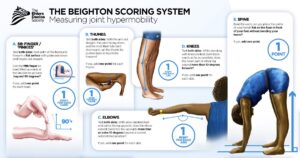BY: Dr. Jennifer Crane, PT, DPT, OCS, ATC (she/her)
@cirque_physio, www.cirquephysio.com
These disorders are highly underdiagnosed, so screening for them in your intake and during the initial evaluation can be incredibly helpful in caring for these patients.
While the beighton scale is an adequate initial screening tool, it has a few flaws that are important to note and address during administration:
- It does not take into account AGE. As hypermobile people age, joints tend to become stiffer to the point of altering their beighton score. The same person who, at age 20, would have a 9/9, may have a 2/9 at age 45 and therefore would not be accurately captured in this test.
- It does not take into account SPORTS-SPECIFIC TRAINING. If your patient has ever been a performing artist, especially before 2010, it is highly probable that they have purposefully applied overpressure to their knees or elbows to encourage hyperextension, as this has long been considered a desirable aesthetic in dance and circus arts. This practice has (mostly) ceased in recent years. However, if your patient has hyperextended elbows and knees, be sure to follow up and ask if their joints have always hyperextended, or if it’s something they acquired through training.
5-point questionnaire
Another screening tool that I often implement is the 5-point questionnaire. This is a subjective test and a great alternative if your patient may not be able to perform the beighton scale tests.

Citation: Hakim AJ, Grahame R. A simple questionnaire to detect hypermobility: an adjunct to the assessment of patients with diffuse musculoskeletal pain. Int J Clin Pract. 2003;57(3):163-166.
Hypermobility Screening Tool
Finally, if your patient already has (or if they suspect) a hypermobility diagnosis, this screening tool is an excellent addition to their intake form. It was created to facilitate efficient patient screening & earlier recognition of hypermobility-related conditions. Additionally, it can also drastically improve interprofessional communication and collaboration with other providers to optimize outcomes for hypermobile patients.
Cultural Considerations
Finally, the EDS/HSD community has its own unique language and culture. Familiarity with a few key concepts can make a big difference in establishing rapport and providing more compassionate and empowering care to your patients.
Join Dr. Jennifer Crane, PT, DPT, OCS, ATC for April’s Functional Dry Needling Lunch & Learn, happening Tuesday, April 25th from 12:00 – 1:00 PM CT, Register Now!
